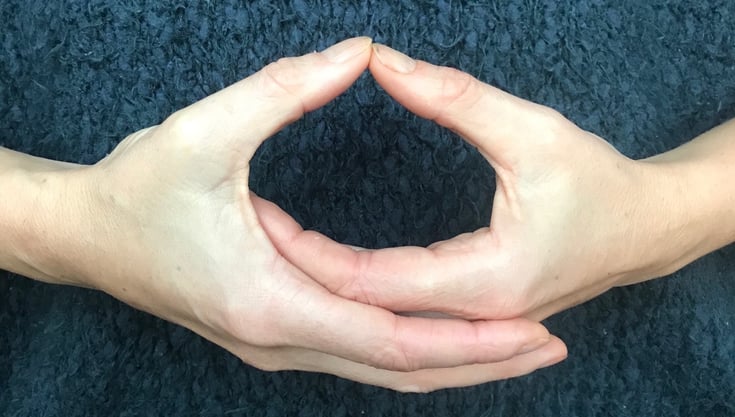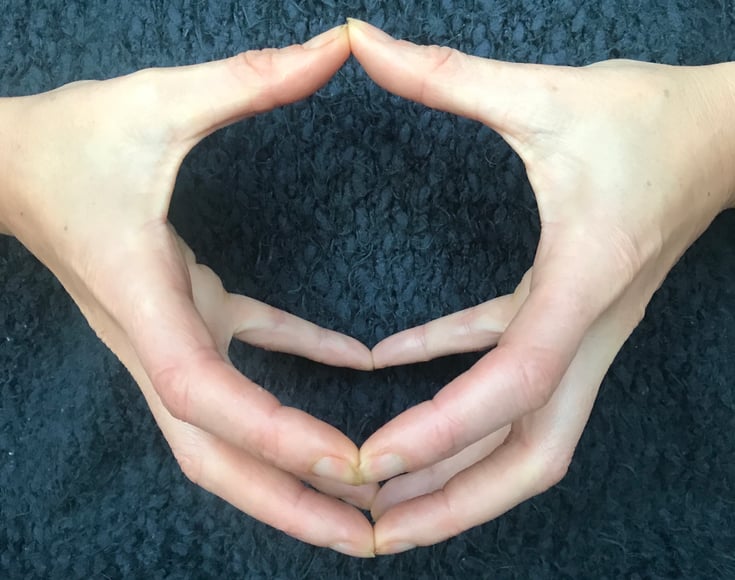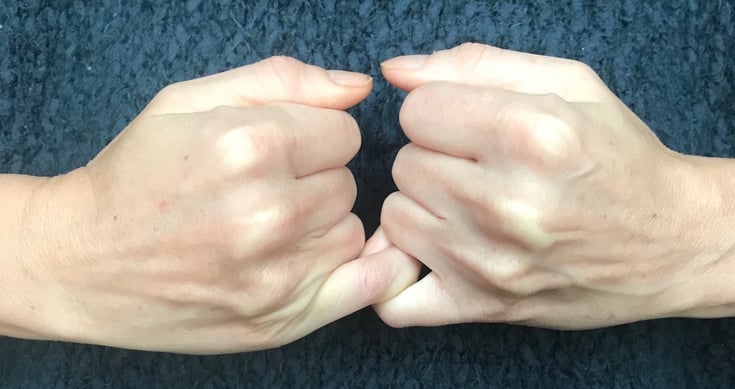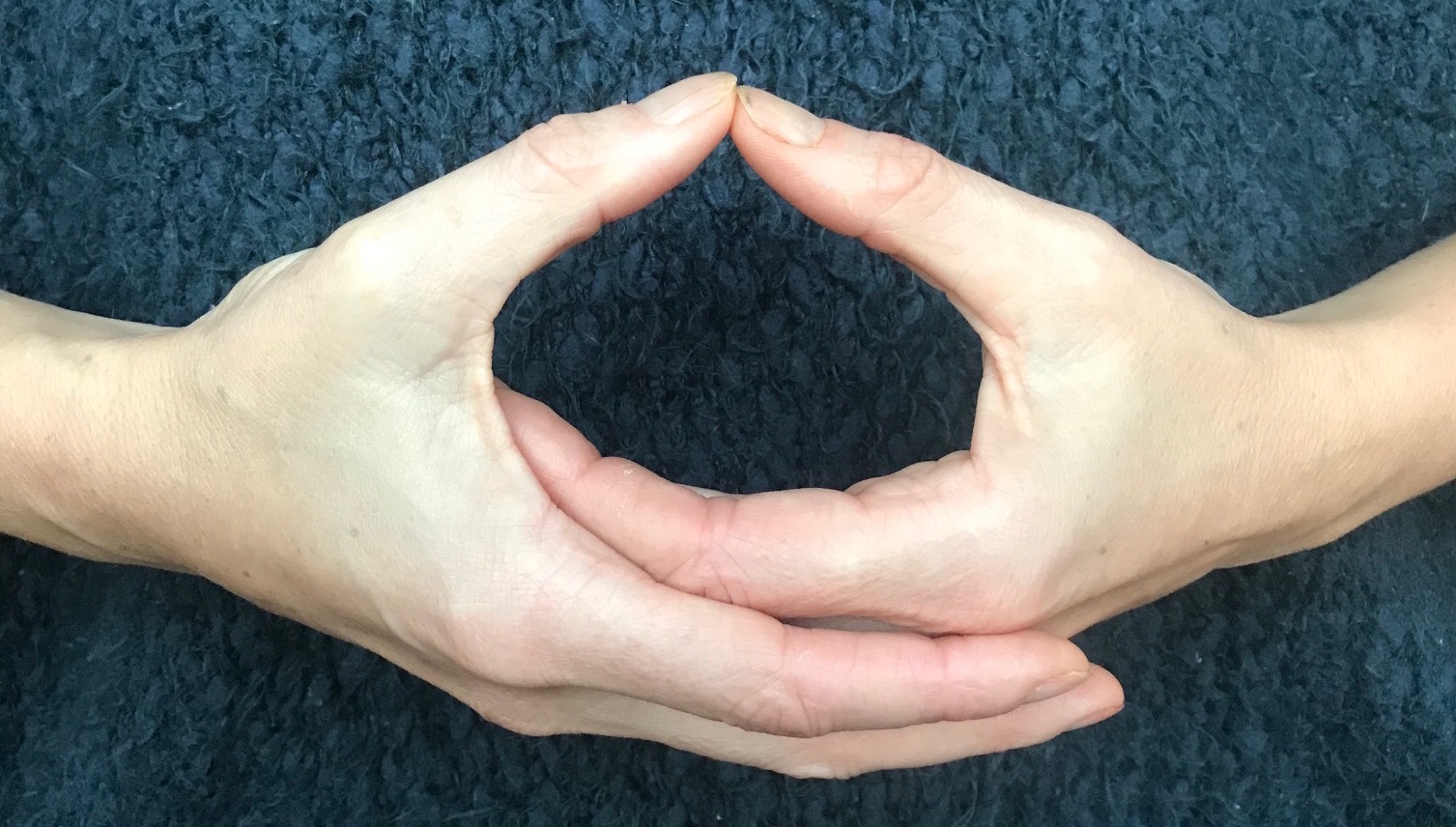Mudras - yoga for airplanes

I just got back from a trip to the USA. 7 glorious days in California, soaking up the sun and sharing my passion for Yoga Therapy with some of the most talented practitioners in the business at the Symposium on Yoga Therapy and Research (SYTAR).
The only downside was the travel – 14 hour flights each way, plus some pretty hectic freeway action on the way from LA to Newport Beach (it's not far, but that whole driving on the other side of the road thing is tricky when you’re sleep deprived…) So how does a yogi stay sane and healthy on long international journeys? Mudras, of course.
Mudras are the obvious choice for economy air travel – they’re discreet (mostly), don’t need much room and won’t worry your neighbour too much. You can do them in the dark (my flights were overnight), in the galley and in the departure lounge. What’s more, mudras have powerful energetic benefits that go beyond the benefits of stretching, leaving you feeling calmer, more relaxed and able to deal with the rigors of travel. Here’s the practice I developed for myself on the LAX-SYD stretch of my trip.
- Preparation - Pawanmuktanasana
These gentle movements helped me to release tension in my arms, neck, shoulders and lower legs. They also keep the circulation going without needing to move around too much – perfect for those snug economy airline seats.
- Finger stretches: Gently curl the fingers down into fists. Inhale to spread the hands and fingers wide like starfish. Exhale to curl the fingers back into gentle fists. Repeat 8 times.
- Wrist rolls: Focusing on the sensations in your wrists, make gentle fists with your hands and roll the wrists in circles. Do 8-10 circles in one direction, then repeat in the opposite direction.
- Fingers to Shoulders: Lengthen the arms out straight in front of you (as much as you have room for!) with palms turned up. Inhale, then exhale to bend the elbows and bring the finger tips to the tops of the shoulders. Inhale to straighten the arms back out their starting position. Repeat 8 times.
- Shoulder rolls: Relax the hands down in your lap. Focus on sensations in your shoulders as you inhale to roll them up and back, then exhale to roll them down and forwards. Do 8 circles like this, then repeat 8 times rolling the shoulders in the opposite direction.
- Hakini Mudra

Hakini mudra is one of my favourites. It balances all three doshas, all five elements and all of the body’s systems. Hakini Mudra also helps to create a sense of whole body-mind-spirit integration, creating both inner and outer harmony – exactly what you need on a long flight.
Practice Hakini Mudra: With your hands at solar plexus level, bring the tips of all the fingers and thumbs lightly together. The fingers are rounded and spread apart, as if you’re holding a crystal ball.
Breath focus: Feel the inhale travel up from the base of the spine to the collar bones. As you exhale, feel the breath travel down from the collar bones to the base of the spine. Allow your breathing and body to be relaxed and soft.
- Kanistha Mudra

Kanistha Mudra is all about grounding. Air travel can be hard on Vata dosha, which is made up of the Ether and Air elements, and when Vata dosha becomes imbalanced you can feel ‘airy’ and ‘spaced out’, disoriented, forgetful and anxious. Kanistha Mudra activates the Earth element, connecting you to the firm, supporting energy of the earth even as you zoom through the Ether. It also connects you to a sense of safety and trust, both of which are valuable for confidence and wellbeing as you travel far from home.
Practice Kanistha Mudra: Gently curl the hands into fists with the knuckles pointing in towards one another and the thumbs on top. Extend the little fingers and hook them around one another, pulling the elbows outwards a little to create a small and gentle sensation of resistance between the linked pinkies.
Breath focus: Direct each breath downwards towards the base of the spine.
- Mandala Mudra

Like Hakini Mudra, Mandala Mudra also balances all of the elements, koshas and systems of the body. It’s also an excellent mudra for meditation, so try Mandala mudra at the end of your mudra practice so you can move straight into a longer meditation.
Practice Mandala Mudra: Place the left hand, palm turned up, onto your lap. Place the back of the right hand into the palm of the left. Place the tips of the thumbs together, raising the thumbs upwards away from the hands to create a circle.
Breath focus: breath naturally and observe the breath and body as the two expand and contract on the inhale and exhale. Continue observing the breath as you maintain Mandala Mudra, moving into a breath meditation
Watch Nikola perform Hasta Mudras (hand mudras) in this short video.


